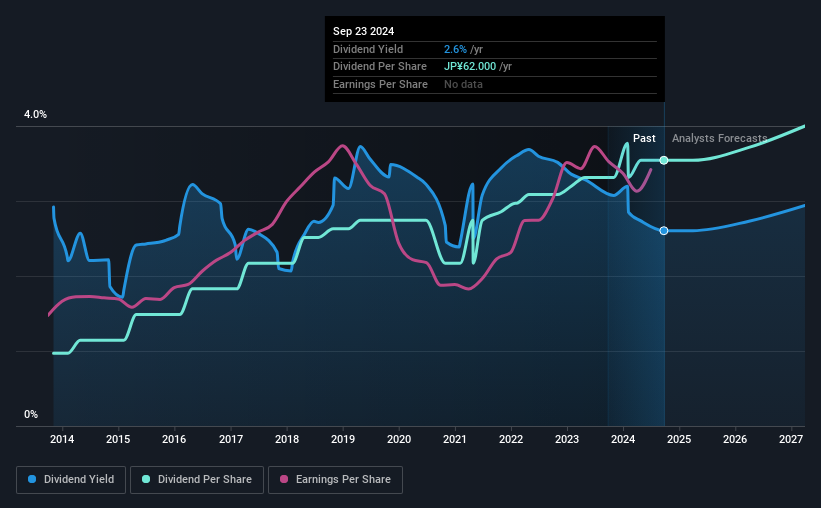- Japan
- /
- Electronic Equipment and Components
- /
- TSE:7510
Takebishi Corporation (TSE:7510) Is About To Go Ex-Dividend, And It Pays A 2.6% Yield

Takebishi Corporation (TSE:7510) is about to trade ex-dividend in the next 2 days. Typically, the ex-dividend date is one business day before the record date which is the date on which a company determines the shareholders eligible to receive a dividend. The ex-dividend date is important because any transaction on a stock needs to have been settled before the record date in order to be eligible for a dividend. Accordingly, Takebishi investors that purchase the stock on or after the 27th of September will not receive the dividend, which will be paid on the 4th of December.
The company's next dividend payment will be JP¥29.00 per share, and in the last 12 months, the company paid a total of JP¥62.00 per share. Calculating the last year's worth of payments shows that Takebishi has a trailing yield of 2.6% on the current share price of JP¥2381.00. Dividends are an important source of income to many shareholders, but the health of the business is crucial to maintaining those dividends. As a result, readers should always check whether Takebishi has been able to grow its dividends, or if the dividend might be cut.
Check out our latest analysis for Takebishi
If a company pays out more in dividends than it earned, then the dividend might become unsustainable - hardly an ideal situation. Fortunately Takebishi's payout ratio is modest, at just 36% of profit. A useful secondary check can be to evaluate whether Takebishi generated enough free cash flow to afford its dividend. What's good is that dividends were well covered by free cash flow, with the company paying out 16% of its cash flow last year.
It's encouraging to see that the dividend is covered by both profit and cash flow. This generally suggests the dividend is sustainable, as long as earnings don't drop precipitously.
Click here to see how much of its profit Takebishi paid out over the last 12 months.

Have Earnings And Dividends Been Growing?
Stocks with flat earnings can still be attractive dividend payers, but it is important to be more conservative with your approach and demand a greater margin for safety when it comes to dividend sustainability. If earnings decline and the company is forced to cut its dividend, investors could watch the value of their investment go up in smoke. With that in mind, we're not enthused to see that Takebishi's earnings per share have remained effectively flat over the past five years. Better than seeing them fall off a cliff, for sure, but the best dividend stocks grow their earnings meaningfully over the long run.
Many investors will assess a company's dividend performance by evaluating how much the dividend payments have changed over time. Takebishi has delivered an average of 14% per year annual increase in its dividend, based on the past 10 years of dividend payments.
The Bottom Line
Is Takebishi worth buying for its dividend? Earnings per share have been flat, although at least the company is paying out a low and conservative percentage of both its earnings and cash flow. It's definitely not great to see earnings falling, but at least there may be some buffer before the dividend gets cut. Overall, it's hard to get excited about Takebishi from a dividend perspective.
On that note, you'll want to research what risks Takebishi is facing. Case in point: We've spotted 1 warning sign for Takebishi you should be aware of.
Generally, we wouldn't recommend just buying the first dividend stock you see. Here's a curated list of interesting stocks that are strong dividend payers.
Valuation is complex, but we're here to simplify it.
Discover if Takebishi might be undervalued or overvalued with our detailed analysis, featuring fair value estimates, potential risks, dividends, insider trades, and its financial condition.
Access Free AnalysisHave feedback on this article? Concerned about the content? Get in touch with us directly. Alternatively, email editorial-team (at) simplywallst.com.
This article by Simply Wall St is general in nature. We provide commentary based on historical data and analyst forecasts only using an unbiased methodology and our articles are not intended to be financial advice. It does not constitute a recommendation to buy or sell any stock, and does not take account of your objectives, or your financial situation. We aim to bring you long-term focused analysis driven by fundamental data. Note that our analysis may not factor in the latest price-sensitive company announcements or qualitative material. Simply Wall St has no position in any stocks mentioned.
About TSE:7510
Flawless balance sheet, good value and pays a dividend.


